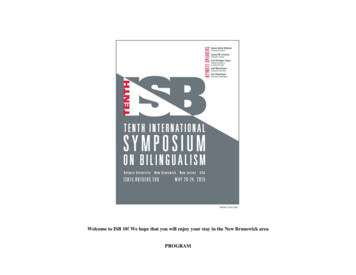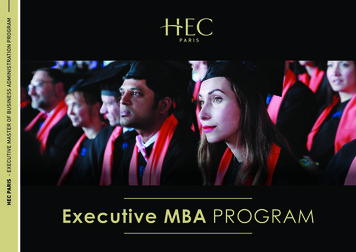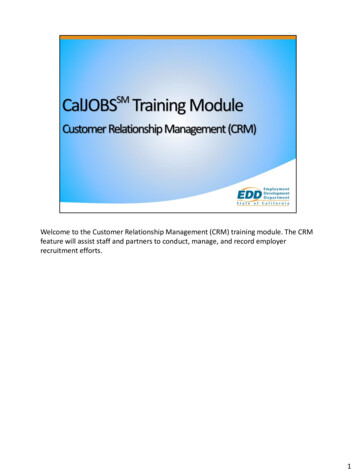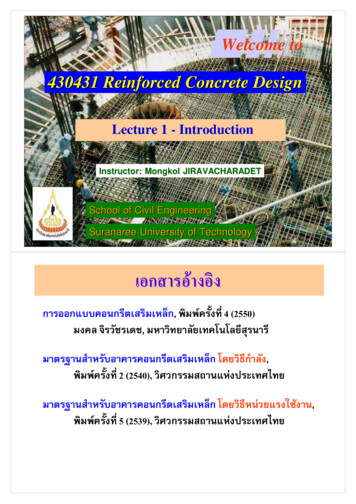
Transcription
Welcome to ISB 10! We hope that you will enjoy your stay in the New Brunswick areaPROGRAM
Wednesday 5/20 Presentation Schedule. All events for Wednesday on the Rutgers campus (Murray Hall and Van Dyke)REGISTRATION (12:00-1:00): Murray Hall, College Avenue CampusTime1:001:151:153:15Murray Hall 2101. Child Code-Switching2. TS: Research in heritage Germanicgrammars: empirical findings andtheoretical challenges1:15Processing of CS sentences bybilingual children: online and offlinemeasureSubject shift and object shift inNorwegian Heritage Language(Gross, Buac, López, Kaushanskaya)The relationship between exposure toCS and language skills in bilingualchildren1:452:152:453:153:30Murray Hall 211Murray Hall 212Murray Hall 213OPENING (Van Dyke 211) Peter March, Executive Dean of the School of Arts and Sciences(Crespo, Gross, Buac, Kaushanskaya)CS in Singaporean English-Mandarin5-6 year olds reveals grammaticalinteraction(Kang, Yow, Li, Lust)Verbalizing as a tool to promoteconceptual development in heritagelearners(García, Pérez-Cortes)3. TS Usage based contactlinguistics: the lexicon grammarcontinuum in code-switching andcontact-induced changeThe use of loan translations and itsconsequences in an oral bilingualcorpus4. TS: Sources of Transfer inAcquisition of L3 Morphosyntax(Anderssen & Westergaard)The (Non)Maintenance of PhonologicalContrasts in Moundridge SchweitzerGerman and Pretty Prairie SchweitzerGerman(Joo, Page & Schwarz)(Bullock, Larsen-Serigos, Toribio)More alike than we thought:creating equivalence betweenTurkish and Dutch in bilingualspeech(Demirçay, Backus)Gender feature transfer from L2Spanish to L3 ArabicRestructuring of word order in HeritageGerman: The case of MoundridgeSchweitzer GermanChunking and word frequencypredict switch placement in thecontext of noun phrases withadjective modifiers in RussianGerman code-mixing(Hopp & Putnam)(Khakimov)Gender attrition in AmericanNorwegian Heritage LanguageThe location of focus inmonolingual Basque sentences vs.bilingual Basque-Spanishsentences(Lohndal & Westergaard)(Lantto)BREAKUsing ERP to test formal models ofThird Language (L3) Acquisition(Rothman & Alemán Bañón)(Goodenkauf & Herschensohn)A Functional Approach to Crosslinguistic Influence in ab initio L3Acquisition(Sanz, Park & Lado)
3:305:005. Bilingualism in education andbeyond6. Perceptions and Use of languageEnglish in FL Contexts and in themedia3:30Variation in sentence repetition taskperformance: how do children inimmersion education compare toother bilinguals?(Scheidnes)Mobilization of linguistic resourcesand science learning amoung youngLatino children in a Spanish-Englishbilingual inquiry curriculum: the roleof translanguaging practices(Martínez-Roldan)The creative, fluid and transgressive useof English in the linguistic landscape ofSuzhou, China4:004:305:005:155:156:155:155:45Concurrent processing of linguisticand musical syntax: comparingbilingual and monolingual musiciansand non-musicians(Ting, McQueen, van Hell)(Li)The changing status/function of Englishin North Africa: the case of Algeria(Benrabah)Multilingualism in the public sphere:Ideologies and practices(Claudio Scarvaglieri)7. TS Usage based contactlinguistics: the lexicon grammarcontinuum in code-switching andcontact-induced change (cont.)Comparing language and syntacticpriming in German-English andGerman-Russian bilingualchildren (Lieven, EndesfelderQuick, Tomasello)Frequency effects in crosslinguistic influence: Learnerstransfer high-frequencyconstructions to the targetlanguage in the acquisition of aclosely related language(Nkombong)Phrasal verbs in Welsh-Englishcontact: A usage-basedperspective8. Bilingual Reading(Rottet)(Babcock, Vallesi)11. Education and executivecontrolA bilingual advantage for youngbeginning EFL learners?(Stevenson, Saarloos, Wijers, deBot)12. Child Bilingual NarrativesMetalinguistic abilities andexecutive function in youngforeign language learners:preschoolers in FL immersion maybenefit more strongly fromrepeated testing than monolinguals(Oberhofer)Experimental teacher training: formfocused instruction in a foreignlanguage contextModelling bilingual sentence reading(Frank)Language control in bilingualreading: evidence from the mazereading task(Wang)The nature versus nature ofsimultaneous interpretationBREAK9. The Bilingual Classroom10. Language Policy and VitalityMultilingual repertoires at school:patterns of language choice duringgroup workLanguage boundaries in America: Is the‘monolingual status-quo’ changing?(Hoffman)(Jordens)Performing ideologies: speaking testsas social practice.(Rydell)The impact of outgroup learners andspeakers on a language revival dynamic(Hifearnáin)Narrative abilities in preschoolers: abilingual-monolingual comparison(De Houwer, Bornstein, Putnick)(Sato, Frenzel)
Thursday 5/21 Presentation Schedule. All events in the HyattREGISTRATION (opens at 8:00): Hyatt8:459:459:4510:00KEYNOTE: Luis Enrique López (Programa de Apoyo a la Calidad Educativa, Guatemala) Title TBA (Regencey DEF)BREAK (Atrium)Conference A13. IndividualDifferences inSLA / AgingSalon A14. ProcessingCode-SwitchingSalon B15. Bilingualismin EducationSalon C16. SignLanguagesSalon D17. FormalApproachesConference I18. BilingualPhonology10:00Learning L2syntax: theintersection oflearningconditions andindividualdifferences(Tagarelli, Ruiz,Rebuschat)ReadingOutcomes inChildren withDiverse LanguageBackgrounds(Luk, Mesite,Leon Guerrero,Christodoulou)Bilingualism inusers of BritishSign Languageand Englishfollowing stroke(Woll)Testing theInitial State: FullTransfer/FullAccess, OrganicGrammar andModulatedStructureBuilding(Rogers)Production ofEnglish codaclusters by 3 yearold monolingualand Mandarin L2learners ofEnglish: anacoustic analysis(Xu Rattanasone,Demuth)10:30Translationambiguity andindividualdifferences in L2vocabularylearning(Tuninetti,Tokowicz,Warren, RiveraTorres)The impact ofpre- and postcuing inlanguageswitching onswitching costsand global RTs(Asaid,Shamshoum,Prior)Is codeswitching costly?Evidence fromdisfluencies andspeech rate inspontaneousbilingualconversation(Fricke, AradNeeman, Kroll,Dussias)Becomingbilingual throughimmersionschooling:cognitivedevelopment andliteracy acquisitionof L2 learners in animmersion schoolenvironment(Hansen, Macizo,Carreiras, Fuentes,Saldaña,Duñabeitia, Bajo)Bimodalbilingual codeblendingcharacteristics(Lillo-Martin,Chen Pichler,Quadros)Focus in theHungarian oflate and guagedominance andprosodic focusmarking in theK’ichee’ ofSpanish K’ichee’bilinguals(Baird)10:0012:00Conference F19. TSCultivatingbilingualidentities:language andliteracy practicesin formal andinformalcontextsTranslanguagingand Biliteracy(Garcia & Wei)Conference JK20. TSContrastingperspectives andeffects oflanguagedominance xperiences withtheir ownBilingualism andTheir Work withTeachingCulturallyLinguisticallyDiverse Students(Jo)The usage-basedperspective oncode-mixing inBFLA acquisition(Gaskin)Code-mixing andLanguageDominance inGerman-Englishbilingual children(Quick, Lieven,Tomasello)
11:0011:30Aging andbilingualprocessing: agerelateddifferences inverbal and nonverbal cognitiveperformancebetween early andlate bilingualsand monolinguals(Houtzager,Sprenger, Lowie,de Bot)Bilingualism andaging: executivefunctions,language use,and managementin normallyaging speakersand speakerswith dementiaSelf-pacedreading of intrasententialcodeswitches inSpanish-Englishbilinguals(Elinsky,Litcofsky, Bajo,Van Hell)A multi-lingualorientation to thelanguagescurriculum: animplementationstudy(Scarino)Whadayaknow?: effectsof previousexposure to aSign Languageon learninganother ticalarchitecture:Syntacticdevelopment inOptimalityTheory(Hsin, Legendre)Early atypicaldevelopment inbilingual speech:from phonetics tophonology(Lewis, :Performance,DiscourseAnalysis andMultilingualIdentities(Harman, Ahn &Bogue)When and whydo they switch?Conversationsbetween parentsand children inRussian-Germanimmigrantfamilies inGermany(Ritter)BilingualEducation inSpain: a FulbrightSenior ScholarResearch Project(Gerena,Ramírez)Workingmemory insecond languageacquisition:effects ofinterlanguagedynamics andmodality(Williams,Darcy)Convergence anddivergence in theacquisition ofergativeabsolutive andnominativeaccusative casesby KaqchikelMaya children(Heinze Balcazar)Thesociophonetics ofsibilants Identities-- wrapup and discussion(Harman)26.Representation of Space andMotion27. AttitudesAbout ForeignLanguageLearningA comparativestudy of studentparticipation intwo bilingualeducationComparingmonolingual andbilingualchildren'sdisambiguationof referentialacts: Effect �ntay)(de Bot, Lind,Ribu, :452:15LUNCH (Regency DEF)POSTERS (Atrium)21. L2Processing/mixing22. Null Objects23. L3Acquisition24. BilingualIdentityCognitiveconstraints canmodulatetransfer inbeginnersCross-linguisticeffects inbilingualacquisition of nullobjects inBrazilian andThe more, thebetter? The caseof L3 learning bybilinguals andmonolinguals.“They call usnames, they callus Russians!”:nationality and25. BilingualPhonologyConsequences oflanguage onspatialrepresentationsamong English-28. L1AttritionRethinking someissues in L1attrition: a casestudy of L1Spanish in
(Sagarra)2:45Linkingcomprehensionand productionin bilinguals(Van Assche,Duyck, Gollan)3:15Languageswitchingconstraints: morethan syntax?Data from ese(Castro, Rothman,Westergaard)Object omissionin CantoneseEnglish BilingualChildren(Zhou, Mai, Yip)(Park)conceptual nonequivalence.(Isurin)How trilingualscontrol language(Mosca, Festman,Clahsen)A sense ofbelonging: therole of languagein thenegotiation andconstruction ofidentity inmultilingualfamilies.(Ballweg)Disentanglingthe effects oflanguage contactand individualbilingualism: thecase ofmonophthongsin Welsh andWelsh English(Mayr, Jonathan,Mennen,Williams)‘Poner oPonerla?’:modeling nulldirect objects innon-nativeSpanish(Peace)Third languagevocabularylearning benefitsfrom each of lismand culturalethos: a sociolinguisticanalysis of thestories ofelderly KoreanAmericans(Kim-Yoon)Production of“new” and“similar” Frenchvowels byfemale Mandarinspeakinglearners inCanada(Li)Mandarinbilinguals(Toh, Suarez)program modelsin the US(Aguirre,Yturriago)Convergence inExploringmotion encodings languagein French-English attitudes andbilingual children ideologies in(Furman, Miller, multilingualNicoladis)Spain: secondarystudents’perspectives onminoritylanguages(Duggan)A constructionalapproach towardsintransitivemotionconstructions inbilingual andmonolingualspeech(Koch, Woerfel)Effects ofbilingualism onattitudes towardsforeign languagelearning(Serkan Yuksek)34. TSCharacterizingmaternalcontributions tothe languageenvironment ofemergingSpanish-Englishbilingualchildren35. TS Newdirections in thestudy ofbilingual lexicaldevelopment:commitment vs.plasticitycontact withBraz. Port.(Iverson)First languageattrition effects inthe onlinerevision ofungrammaticality: ERPevidencechallenging thecritical e contactand languageattrition:restructuringprocesses inBarossa-German(South-Australia)(Riehl)BREAK (Atrium)Presentation of the Rutgerschapter of BilingualismMatters31. TSEthnography oflanguage policyin Europe:understandinghow differentactors make theirown languagepolicy32. TSBilingualismand Creativity33. TS Creatingbilingual space:a cross-culturalstudy ofreflections ofpre-primaryteachers on theirflexiblelanguagepractices36. TS Doesbilingualismimpose desirabledifficulties?
4:154:45Presentation of the Rutgerschapter of BilingualismMatters (Conference A)The Interplaybetween FamilyLanguage Policyand EducationalLanguage Policy:an ethnographiccase study of twomultilingualfamilies inLuxembourg(Made)Language Policyin Practice inEarly ChildhoodEducation andCare: Anethnographicstudy of amultilingual daycare center inStrasbourg(France)(Hélot, iveFunctionAbilities andCreativity(Leikin &Woldo)LanguageMediatedConceptActivation inBilingualMemory as aFacilitatoryCognitiveMechanism ofCreativeBehavior(Kharkhurin, &Isaeva)Implementingconcurrentbilingualpractices in amonolingualspace:Reflections of abilingual preprimary teacherin FinlandVocabularygrowth inSpanish andEnglishmonolingual anddual languagelearnersÅsa Palviainen& Karita MårdMiettinenBilingual vs.monolinguallanguage use inbilingualeducation:Opinions ofkindergartenteachers(Friend, DeAnda,Zesiger &Poulin-Dubois)Impacts of SESand MaternalVerbalInput/Responsivity on the EarlyLanguageAbilities ofEmergingBilingual Children(Protassova)(Cates,Weisleder,Berkule, Dreyer,Mendelsohn)"It's simplyblue":Fossilization andrestructuring inthe bilingualcolor lexicon4:15-4:30Overview (Bjork)(Pavlenko &Jarvis)Bidirectionallexical interactionin late l Practiceas a DesirableDifficulty forLearning ForeignLanguageVocabulary(Kang)(Malt, Li,Pavlenko & Zhu)4:30-4:50Bilingualism: ADesirableDifficulty thatShapes MemoryControl (Morales,Gomez-Ariza &Bajo)5:10-5:30Making n andTransfer:Extensions andQualifications ofthe der, andBourne)5:30-5:50
5:1529. Codeswitching(ConferenceA)From ‘classic’codeswitching to‘radical’ codemixing inSuperdiversity(Bolonyai)5:45On thetheoretical andempiricalbases oftranslanguaging(Bhatt,Bolonyai)30. Heritagespeaker learningLanguage as apolitical issue ineducation:GermanElementarySchools ismand multilingualschoolenvironments(Leichsering)From EuropeanLanguage Policyto PracticedLanguage Policyin a Chinese as aForeign Languageclass in France:Analysis of theNotion ofPlurilingualCompetence(Chen)BOOK EXHIBIT in the ATRIUM Thursday-SaturdayBilingualismand the creativeside ofcognition(Cushen, Jarosz,Mielicki, &Wiley)A MultivariateApproach to tors andPolicyImplications(Fürst & ies: ThePotential ofPlurilingualism(Piccardo)Facingchallenges inrealization oflanguageeducationalpolicies throughthe lens ofteachers: A caseof )BilingualMothers’Language ofEducation, notLevel nt(Hoff & Giguere)Policies andpractices ofimmigrantlanguageinclusion in atrilingualpreschool groupin Sweden(Puskás)Discussion(Shiro)Effects oflearning contexton L2 lexicalacquisition:behavioral andfMRI evidence(Legault, Fang,Wang, Lan & Li)Lexicalproficiency in L2ultimateattainment:Accounting foreffects of age ofacquisition andbilingualism(Norrman &Bylund)Are BilingualDisadvantagesEvidence ofDesirableDifficulty or Justan EmergentProperty ofRegularly UsingMore than ties inlearning:Explaining thebilingualadvantage invocabularylearning(Bogulski &Kroll)
Friday 5/22 Presentation Schedule All events in the HyattREGISTRATION (opens at 8:00) at the Hyatt8:459:459:4510:00KEYNOTE: Juana M. Liceras (University of Ottawa) “Language dominance and interlinguistic influence in bilingual L1 acquisition (2L1): The variousfacets of our 2L1 ‘imitation game’ ” (Regency DEF)BREAK (Atrium)Conference A10:00- 37. The Role of12:00 Script andOrthography10:0010:30Conference F38. L2ProcessingRecognitionmemory for newcharacters andwords bybilinguals withdifferent writingsystems(Suarez)Pinyin interferenceeffects duringMandarin wordrecognition(Ng, Suarez,Veera)Omission vsCommission:an ERP studyof subject-verbagreementviolations inMandarin L2-Conference I39. TS Neuralcorrelates ofbilinguallanguageprocessing:usingbilingualism tostudy brainplasticityLanguageswitching ingmore than onelanguage in thebrain: It’s aboutthe nativelanguage too!(Kroll & Bice)Conference JK40. TS Codeswitchingacross the lifespan: newdata onspeaking andlisteningSalon A41.TSBilingualism andlanguage contactscenarios in LatinAmericaSalon B42. TSUnpackingbilingualexecutivecontrol: speedof processingand languageproficiencySalon C43. TS‘Bilingualismis a matter ofdegree’: asymposium inhonor ofElizabethBatesSalon D44. TS Earlybilingualdevelopment andwell-being: insightsfrom a new subfieldof researchMira elFroggie:LanguageMixing n,Dreyer,Vlahovicova,Catalan Molina,Mendelsohn)The Impact ofCodeSwitching on20-month-oldBilinguals’Comprehension (Morin-Object doubling inSpanish indifferent cases oflanguage contact(Bruhn deGaravito &Ramirez)Effects oflanguageproficiency onspeed ofprocessing inexecutivefunction tasks inchildren(Marton &Campanelli)BilingualCategorizationReveals CrossLanguageLexicalSemanticCompetition inNaming(Zinzszer &Li)Introduction: Theimportance ofinvestigating earlybilingualdevelopmentandwell-being(De Houwer)Specificcognitiveabilities inbilingual andmonolingualyoung adultsUsing theCompetitionModel toanalyze codeswitching inchildren andadultsVariability at theinterfaces: Cliticsin Bilingual andMonolingualAndean SpanishThe family contextof Latino toddlersgrowing up“bilingual”:Language and socialskills(Cabrera, Aldoney,& Malin)The role of Spanishand Englishproficiency and selfregulation in theacademic well-beingof Latino children of
luences on theskill differences inlearning to readEnglish ess andSpellingDevelopment inEnglish as aForeign Languageby Arabic NativeSpeaking Students(Elouty andSaiegh-Haddad)learners ofEnglish(Dube, Peter,Kung,Demuth)Referentialchoice in asecondlanguage:evidence fromhighlyproficientlearners ofEnglish(Contemori &Dussias)Internal andexternalvariables inolder adultSLA:bilingualismand explicitinstruction(Cox, Sanz)Inhibitorycontrol duringsentential codeswitching:evidence fromfMRI (Rossi,Newman, Diaz,Dussias, Ting &van Hell)The use ofcognitive controlin thecomprehensionof SpanishEnglish codeswitching (Theuse of cognitivecontrol in thecomprehensionof SpanishEnglish codeswitching(Valdes Kroff,Thompson-Schill& Trueswell)Lessard, LewWilliams,ByersHeinlein)(Mayer &Sanchez)Look at sing )Quechua-Spanishlanguage contactand the syntax,morphology andprosody ofinformationstructure:evidence fromBolivia, Ecuadorand Peru(Muntendam)AsymmetricalSwitchingCosts duringIntraSententialLanguageSwitching: EyeMovementEvidence forthe Role of L2Proficiency(Pivneva,Titone)Discussion(Gathercole &González)(Goral, Marton,Campanelli,Yoo)The role ofsecond languageproficiency inthe speed oflexicalretrieval,inhibition, and shifting"(Higby, &Obler)Speed-of-switchcosts inbilingual lexicalretrieval(Yoon, Goral,Marton, Obler)(MacWhinney)The cognitiveimpact ofdifferencesamongbilinguals inearly guagecontrol and thebilingual brain(Hernandez)LUNCH (Regency DEF)Business meetingPOSTERS (Atrium)KEYNOTE: Lee Osterhout (University of Washington), title TBA (Regency DEF)immigrants (Collins& Toppelberg)Bidirectionalrelations betweenearly childhoodbilingualism andacademic,behavioral,and socialcompetence amonglow-income,immigrant, EnglishLanguage Learnersin the U.S. (Winsler,Curby, Kim & DeFeyter)Discussion:Harmoniousbilingualism andwell-being: Theimportance of gettingthe relationship right(Ortega)
3:153:453:455:45BREAK (Atrium)45. Language andImmigration46. TSBilingualismand aging:neurocognitiveandneurolinguistics perspectives47. TS Heritage,community andnative
All events for Wednesday on the Rutgers campus (Murray Hall and Van Dyke) REGISTRATION (12:00-1:00): Murray Hall, College Avenue Campus Time Murray Hall 210 Murray Hall 211 Murray Hall 212 Murray Hall 213 1:00-1:15 OPENING (Van Dyke 211) Peter March, Executive Dean of the School of Arts









![Welcome [ shambhalamartialarts ]](/img/2/welcome-packet.jpg)

